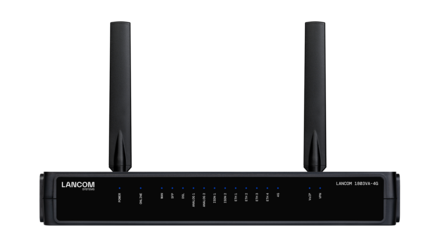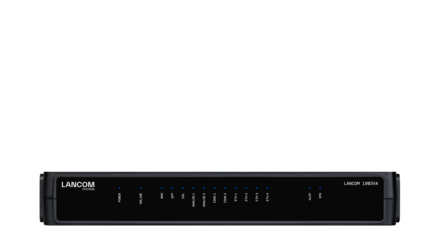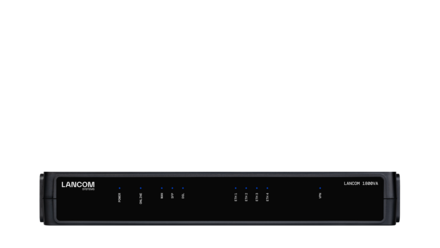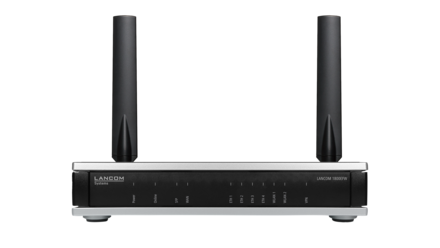What are fiber optic connections?
Glass fibers act as an optical transmission line. In contrast to DSL connections, the signals are not transmitted electrically, but optically using pulsed light. Transmission speeds within the fiber are extremely fast at 2/3 the speed of light. Fiber optics are a key element for future broadband Internet expansion. It offers almost unlimited bandwidth capacity and extremely low signal attenuation. This makes fiber optics ideal for transmitting large amounts of data over long distances.
Fiber optic cables are made up of several individual quartz fibers. These wafer-thin fibers transport the light waves and are combined into bundles. A single fiber optic cable is made up of four components: the core, the cladding, the buffer, and the outer jacket.
- The core (1) is as thin as a human hair and transmits the signals.
- The cladding (2) helps to guide the light by preventing it from leaving the fiber.
- The buffer (3) and
- the outer jacket (4) serve as protection from mechanical damage.

Fiber optic accesses
Instead of using copper expansion via DSL or cable in the past, modern connections are now being made available via fiber optics – either to the apartment with FTTH or to the house with FTTB. So before you can benefit from fast data transmission, you have to check which connection is available.
FTTH (Fiber to the Home)
In this instance the fiber-optic cabling is routed to the individual apartment or company building. The hand-over point between the FTTH network of the telecoms provider and the customer's house network features an Optical Network Terminal (ONT), which converts the fiber-optic signal into an electrical signal for distribution in the house network. FTTH uses three different access technologies that use fiber optics as a transmission medium, but which offer different properties and functionality; namely GPON, XGS-PON, and AON (also known as Active Ethernet).

A Gigabit Passive Optical Network (GPON) is a shared medium, comparable to a cable network. The optical fibers from several households are aggregated by a passive optical splitter and share the same line to the network operator. Each network operator line provides a data rate of 2.5 Gbps for download and 1.25 Gbps for upload. The primary advantages of GPON for the network operator are that fewer optical fibers need to be laid and the port density at the exchange is higher.
The 10 Gigabit Symmetric Passive Optical Network (XGS-PON) for short, is a further development of GPON. It offers symmetrical transmission rates of 10 Gbps, meaning that the upload and download speeds are the same and ideal for demanding applications. The transition to XGS-PON requires not only the implementation of new optical network infrastructures, but also changes to the end devices, especially routers, used in homes and businesses.

Active Optical Networks (AON) or Active Ethernet are point-to-point connections between the subscriber and the network operator. Each subscriber has a separate line to the network operator's exchange, also known as PoP or CO. As a rule, Ethernet is used as the transmission protocol and offers a symmetrical speed of 1 Gbps for downloading and uploading. The great advantage of AON is that the data rate is not shared with other subscribers and each user thus has guaranteed performance. Consequently, every customer has the full bandwidth available at all times—even at peak periods. Furthermore, having a separate line makes it less susceptible to interference. The strengths of Active Ethernet are thus particularly advantageous for business applications.
FTTB (Fiber to the Building)
Here, too, the fiber optics are routed into the building. Here they generally terminate at a hand-over point that transfers the fiber optics into the copper-based house network. The residential / company units in the building thus share the bandwidth arriving over the fiber optics.

Instead of laying fiber optics to every household, FTTB terminates the fiber optics in a service connection room that may be in the basement, or in the immediate vicinity of the building. From here, the final few meters to the subscriber are often bridged by the copper twin-core wiring of the existing telephone cables.The transmission technology is G.fast, a DSL-based technology that is optimized for high-performance transmission over short distances. This enables data rates of over 1 Gbps for each subscriber. A result of this is that the data rate decreases rapidly with increasing line length due to the strong attenuation in the copper wire pair. The advantage of FTTB in combination with G.fast is that you can reuse the subscriber's existing infrastructure without having to accept speed deficits. The initial costs are low and the network can be expanded rapidly. This makes G.fast an ideal bridging technology.
Applications & advantages
Fiber-optic networks are unrivaled in terms of speed and stability: Companies with a need for high bandwidths can accelerate their applications and processes by implementing precisely tailored LANCOM solutions.

Safe and stable
Due to their material, optical fibers are protected against external influences such as weather, fires or magnetic fields. Interference and failures are significantly reduced. In addition, optical fibers have a high level of data security, as it is complicated to physically intercept the data streams.

Maximum sustainability
No other wired technology enables such fast and stable bandwidths as fiber optics - and this will remain the case for the foreseeable future. Those who can upgrade their business connections today and use the appropriate hardware will be able to use the latest technology standard for a long time.
























